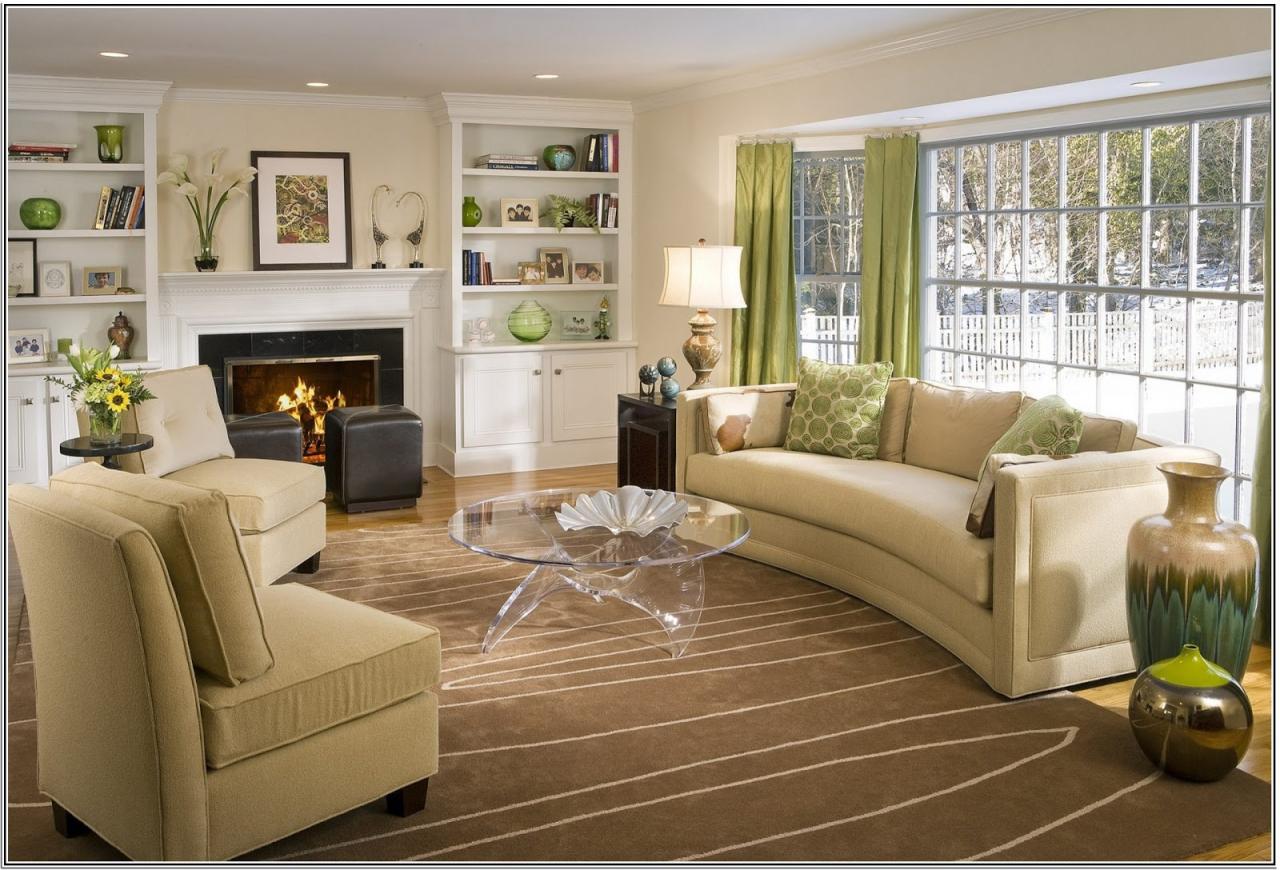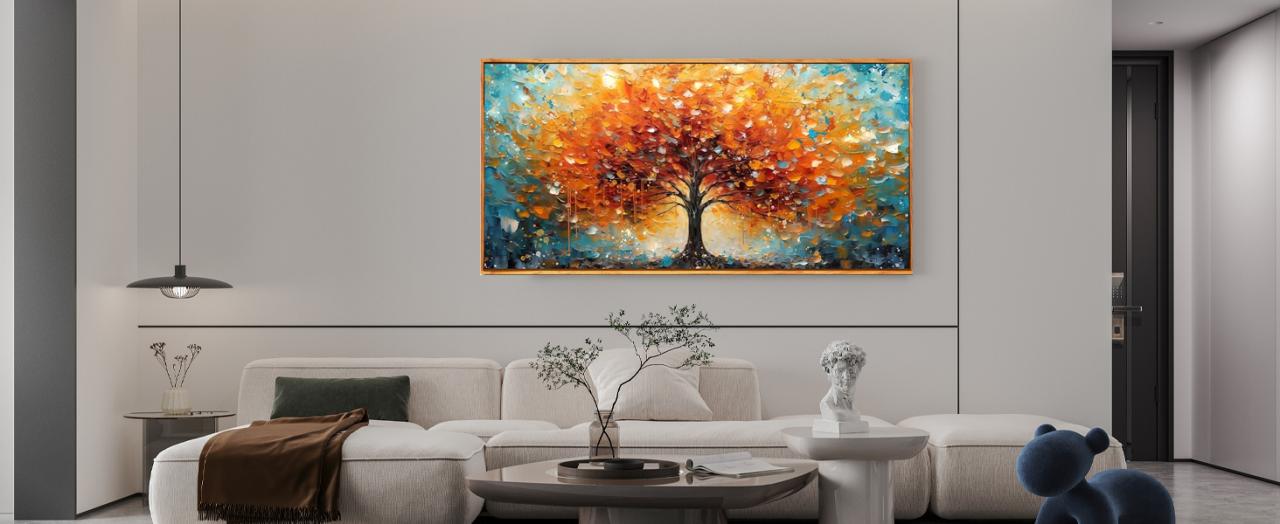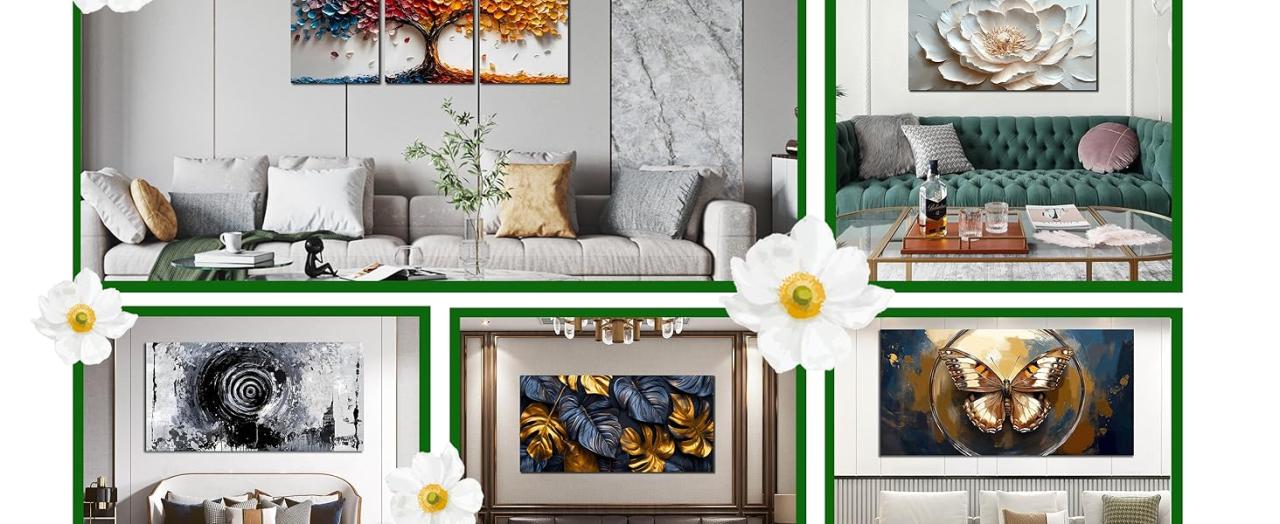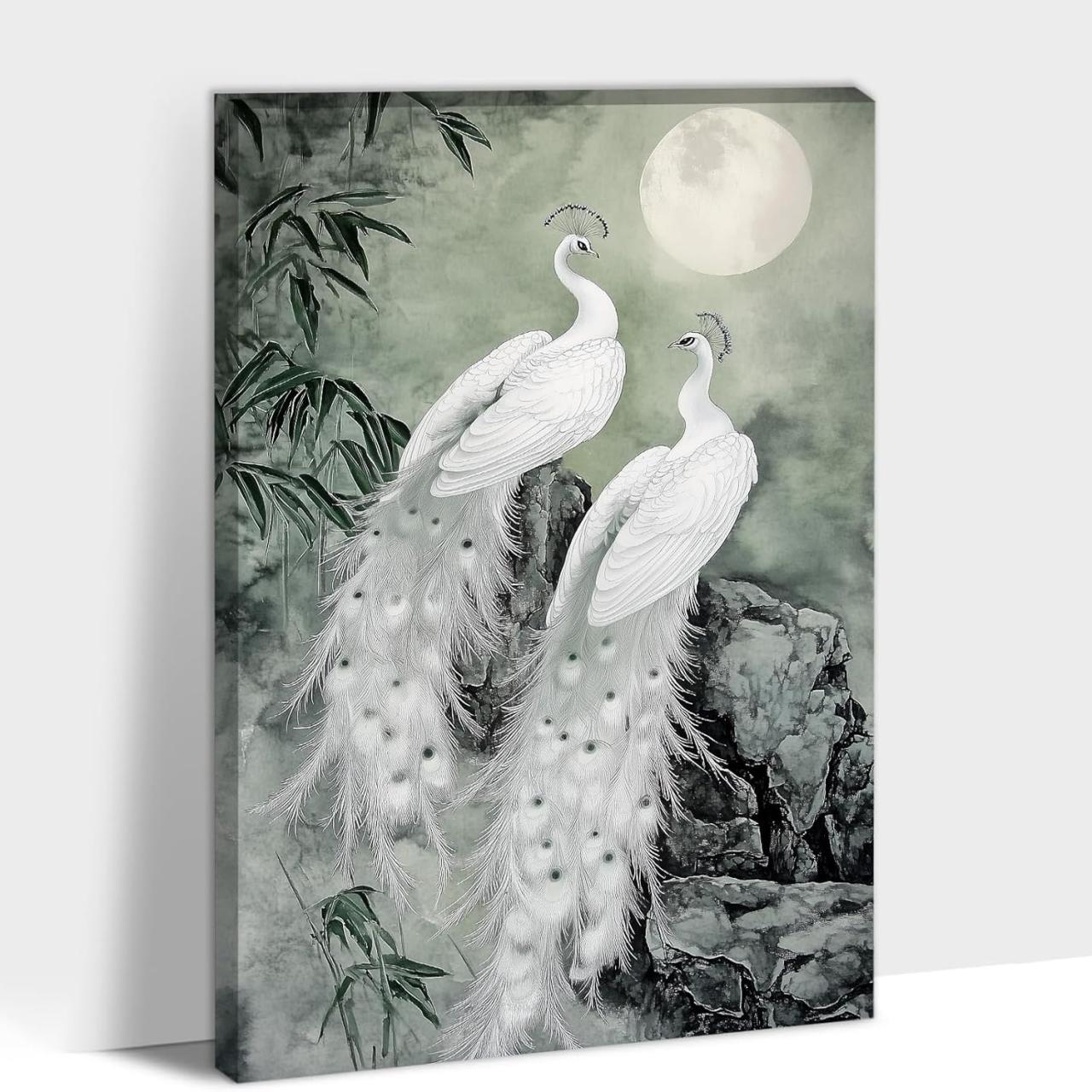Wall art for living room: Transforming a house into a home often hinges on the perfect finishing touches, and what better way to inject personality and style than with carefully chosen wall art? From minimalist masterpieces to maximalist marvels, the options are endless. This guide delves into the art of selecting, placing, and styling wall art to create a living room that’s both visually stunning and deeply personal.
We’ll explore various styles, sizes, color palettes, and materials to help you discover the perfect pieces to reflect your unique taste.
Choosing the right wall art is more than just picking a pretty picture; it’s about understanding the principles of design, color psychology, and how different pieces can interact with your existing furniture and decor. Whether you’re aiming for a calming oasis or a vibrant hub of activity, the right wall art can set the tone and elevate your living space to a whole new level of comfort and sophistication.
Popular Wall Art Styles for Living Rooms

Choosing the right wall art can dramatically transform your living room’s ambiance, reflecting your personal style and creating a space you love. From minimalist elegance to maximalist vibrancy, the options are vast. Understanding different styles and how they interact with your furniture is key to achieving a cohesive and aesthetically pleasing design.
Five Popular Wall Art Styles for Living Rooms
The selection of wall art for a living room is a crucial design decision, impacting the overall feel and aesthetic. Five styles consistently stand out for their versatility and impact: Abstract art offers a non-representational approach, focusing on color, form, and texture to evoke emotion and create visual interest. Landscape art brings the beauty of nature indoors, providing a calming and often serene atmosphere.
Geometric art utilizes precise shapes and patterns to create a modern and structured look, ideal for contemporary interiors. Photography, whether fine art prints or personal snapshots, adds a personal touch and can range from minimalist black and white to vibrant color explosions. Finally, typography art uses text as a visual element, offering a unique opportunity to incorporate quotes, words, or even song lyrics into the room’s design, creating a personalized and meaningful statement.
Minimalist Versus Maximalist Wall Art in Living Room Design
Minimalist wall art emphasizes simplicity and clean lines, often featuring a single piece or a small collection of carefully curated items. This approach prioritizes negative space, creating a sense of calm and spaciousness. A minimalist living room, for example, might feature a single, large abstract canvas in muted tones. Conversely, maximalist wall art embraces abundance and visual richness.
Multiple pieces of varying sizes, styles, and colors are used to create a dynamic and layered look. A maximalist living room might showcase a gallery wall with a diverse collection of framed prints, tapestries, and even sculptural elements. The choice between minimalist and maximalist depends entirely on personal preference and the overall design aesthetic of the living room.
A minimalist approach is ideal for smaller spaces or those seeking a sense of tranquility, while a maximalist approach suits larger rooms and those who enjoy a more eclectic and visually stimulating environment.
Complementing Living Room Furniture Styles with Wall Art
The style of your wall art should complement your existing furniture. Abstract art, with its versatility, pairs well with both modern and traditional furniture. A bold abstract piece can add a pop of color to a neutral-toned modern living room, while a more muted abstract piece can enhance the elegance of a traditional space. Landscape art, with its natural themes, complements rustic and farmhouse styles beautifully.
Imagine a serene landscape painting above a fireplace in a room furnished with reclaimed wood and cozy textiles. Geometric art’s clean lines and structured forms are perfect for contemporary and mid-century modern furniture styles. The sharp angles and patterns of geometric art echo the clean lines of modern furniture, creating a cohesive and stylish look. Photography, with its wide range of subjects and styles, can adapt to various furniture styles.
Black and white photography can add a sophisticated touch to a traditional setting, while vibrant travel photos can complement a bohemian or eclectic space. Typography art, with its personalized message, can complement any style, depending on the font, color, and message itself. A minimalist typographic print could work well in a modern setting, while a more ornate design could add character to a vintage-inspired room.
Comparison of Popular Wall Art Styles
| Style | Color Palette | Materials | Overall Mood |
|---|---|---|---|
| Abstract | Highly variable; can range from monochromatic to vibrant and multi-hued | Canvas, acrylics, oils, mixed media | Evocative, emotional, stimulating |
| Landscape | Often natural tones; greens, blues, browns, but can also be vibrant | Canvas, watercolor, oil, print | Serene, calming, peaceful |
| Geometric | Can be monochromatic or use a limited color palette; often bold | Canvas, metal, wood, print | Modern, structured, clean |
| Photography | Highly variable; depends entirely on the subject and style of the photograph | Print on various materials (canvas, paper, metal), framed or unframed | Varied; can be nostalgic, documentary, artistic, etc. |
Choosing the Right Size and Placement of Wall Art

Picking the perfect wall art for your living room is only half the battle. The other half? Mastering the art of size and placement to create a visually stunning and balanced space. Get it wrong, and your beautiful artwork can end up looking lost or overwhelming. Get it right, and you’ll elevate your living room from “nice” to “wow.”Visual balance and proportion are key when it comes to wall art placement.
Think of your living room as a canvas, and your furniture and artwork as the elements that compose it. You want a harmonious arrangement, avoiding areas that feel too heavy or too empty. The size of your artwork should relate to the size of your furniture and the overall dimensions of the room. Too small, and it’ll get swallowed; too large, and it’ll dominate the space, potentially disrupting the flow.
Living Room Layouts Showcasing Wall Art Placement
Here are three different living room layouts illustrating unique approaches to wall art placement and sizing.
Layout 1: The Classic Focal Point
Choosing the right wall art for your living room is key to setting the mood. To truly elevate the space and achieve that coveted luxurious feel, consider incorporating pieces that reflect a minimalist aesthetic; check out this guide on how to achieve a luxurious minimalist home design for more inspiration. Subtle, high-quality artwork, perhaps a single, impactful piece, will perfectly complement a minimalist living room and add a touch of sophisticated elegance.
Imagine a spacious living room with a large, plush sofa as the centerpiece. Above the sofa, a striking oversized landscape painting (approximately 60″ x 40″) acts as a powerful focal point. The painting’s rich colors and dramatic composition draw the eye and anchor the seating area. Other smaller pieces of art are strategically placed elsewhere in the room, but the large painting remains the undeniable star.
Layout 2: The Gallery Wall
This layout features a smaller living room with a more eclectic vibe. A gallery wall above a console table displays a collection of framed prints, photographs, and small paintings, varying in size and style but maintaining a cohesive color palette. The gallery wall is carefully curated, creating a sense of visual interest and personality without overwhelming the smaller space.
The pieces are arranged in a balanced manner, avoiding any overly dense areas.
Layout 3: The Asymmetrical Approach
In a large, open-plan living room, a more asymmetrical approach can work wonders. A single, large abstract piece hangs off-center on a long wall, creating a visually interesting focal point. The artwork’s bold colors and unique shape contrast with the clean lines of the minimalist furniture. Smaller pieces of art are strategically placed in other areas to complement the main piece, but the asymmetrical placement of the large artwork is the defining feature of this layout.
Wall Art Size Relative to Room and Furniture Size
The size of your wall art should always be in proportion to the size of the room and the furniture it’s placed above or near. A good rule of thumb is that the artwork should be roughly two-thirds to three-quarters the width of the furniture piece it’s paired with. For example, above a 72″ wide sofa, a 48″ to 54″ wide piece of art would be well-proportioned.
In smaller rooms, opt for smaller pieces to avoid overwhelming the space. In larger rooms, larger pieces can be used to create a powerful statement, but always consider the overall balance of the room.
Creating a Focal Point with Large Art or a Gallery Wall
A large piece of wall art, like a tapestry or a statement painting, instantly becomes a focal point, drawing the eye and anchoring the space. It creates a visual anchor that grounds the room and directs the flow of traffic and attention. A gallery wall, when carefully curated, achieves a similar effect. By grouping smaller pieces together, you create a cohesive focal point that showcases your personality and style.
The key is to ensure that the gallery wall doesn’t become cluttered or overwhelming; maintain a balanced arrangement with varying sizes and styles.
The Impact of Color and Theme on Living Room Wall Art

Choosing the right wall art isn’t just about aesthetics; it’s about creating a specific mood and atmosphere in your living room. Color psychology plays a significant role, influencing how we feel and interact within the space. Understanding this can help you select pieces that enhance your living room’s overall vibe and reflect your personal style.Color psychology suggests that different colors evoke different emotional responses.
Warm colors like reds and oranges tend to stimulate energy and excitement, while cool colors such as blues and greens promote calmness and relaxation. Neutral tones, including beiges, grays, and whites, offer versatility and a sense of tranquility. The careful selection of colors in your wall art can significantly impact the overall feeling of your living room.
Color Palettes for Living Room Wall Art
Three distinct color palettes can create diverse moods in a living room. A vibrant palette, incorporating bold reds, oranges, and yellows, could feature a piece depicting a bustling cityscape at sunset, its warm hues echoing the energy of the colors. A serene palette, featuring calming blues, greens, and soft whites, might include a tranquil landscape painting of a forest or ocean scene, promoting relaxation.
Finally, a sophisticated palette using muted grays, creams, and deep blues, could showcase an abstract piece with subtle color variations, creating an atmosphere of elegance and refinement. The artwork’s style should complement the palette’s overall tone.
Choosing the right wall art can totally transform your living room’s vibe. To get the complete look, you’ll want to consider your overall furniture scheme, perhaps starting with a stunning new living room sets to create the perfect backdrop. After all, the right sofa and coffee table will highlight your carefully chosen wall art, ensuring your space feels perfectly balanced and stylish.
Choosing Wall Art that Complements or Contrasts with Existing Decor
The existing color scheme and décor of your living room should guide your wall art choices. If your living room is predominantly neutral, a vibrant piece of art can inject personality and visual interest. Conversely, if your living room is already filled with bold colors and patterns, a more subdued piece of art might prevent visual overload and create a sense of balance.
Consider using the “60-30-10 rule” of interior design: 60% dominant color, 30% secondary color, and 10% accent color. Your wall art can serve as that accent, adding a pop of color or texture that complements the overall scheme without clashing. Alternatively, a contrasting piece can create a focal point and add visual dynamism.
Thematic Ideas for Living Room Wall Art, Wall art for living room
Selecting a theme helps to create a cohesive and purposeful look. Consider these five thematic approaches:
- Nature: A botanical print, a landscape photograph, or a painting of a serene natural scene can bring the outdoors in, creating a calming and refreshing atmosphere. Imagine a large-scale photograph of a majestic mountain range, evoking a sense of awe and tranquility.
- Travel: Artwork depicting iconic landmarks, vibrant street scenes, or abstract representations of faraway places can evoke memories of past adventures or inspire future travels. A framed map of a favorite travel destination could add a personal touch and spark conversation.
- Abstract: Abstract art allows for a wide range of interpretations and can add a modern and sophisticated touch. A large canvas with bold geometric shapes or flowing lines can create a striking focal point. Consider a piece using complementary colors for a harmonious look.
- Family Portraits: A gallery wall showcasing family photos or a single, professionally taken portrait can personalize the space and add warmth. Consider using consistent frames for a cohesive look. A black and white portrait could add a touch of classic elegance.
- Geometric Patterns: Geometric patterns are versatile and can complement a variety of styles. A piece featuring bold, colorful geometric shapes can add a modern and playful touch. Consider a piece featuring subtle, muted tones for a more understated look. A large-scale piece with a repeating pattern can add visual interest and texture to a wall.
Materials and Mediums for Living Room Wall Art: Wall Art For Living Room
Choosing the right materials and mediums for your living room wall art is crucial for achieving the desired aesthetic and ensuring its longevity. The options are diverse, each offering a unique blend of visual appeal, durability, and cost. Understanding these differences will help you make an informed decision that perfectly complements your interior design.
The material and medium you select significantly impact the overall feel of your living room. A vibrant canvas print might inject a burst of modern energy, while a serene framed photograph could foster a calming atmosphere. Similarly, the choice between a sleek metal print and a textured sculpture will drastically alter the visual weight and texture within the space.
Consider the existing décor, lighting, and the overall mood you want to create when making your selection.
Canvas Prints, Metal Prints, and Framed Photographs: A Comparison
Canvas prints, metal prints, and framed photographs represent three popular choices for living room wall art, each with its own strengths and weaknesses. Canvas prints offer a classic, textured look, often preferred for their artistic feel and relatively affordable price point. However, they are susceptible to damage from moisture and require careful handling. Metal prints, on the other hand, boast exceptional durability and vibrant color reproduction, making them ideal for high-impact visuals.
Their sleek, modern aesthetic is a perfect fit for contemporary living rooms. However, they can be more expensive than canvas prints. Framed photographs, a timeless choice, offer versatility in style and can be easily customized to suit any decor. The durability and longevity depend largely on the quality of the frame and the protective glass used.
Mediums and Their Impact on Living Room Aesthetics
The medium used—painting, photography, or sculpture—significantly influences the overall aesthetic of a living room. A large oil painting can become a striking focal point, adding depth and richness to the space. Photography, with its ability to capture moments and evoke emotions, can create a more personal and intimate feel. Sculptures, whether abstract or representational, introduce a three-dimensional element, adding texture and visual interest, particularly in larger living rooms.
For instance, a minimalist sculpture can complement a modern space, while a more ornate piece might suit a traditional setting.
Material Advantages, Disadvantages, and Cost
The durability, maintenance, and cost of different wall art materials vary considerably. Canvas prints are generally affordable but require careful handling to avoid damage. Metal prints are highly durable and low-maintenance but come with a higher price tag. Framed photographs offer a wide range in price depending on the frame, matting, and the print itself; their maintenance is relatively straightforward.
Consider the level of traffic in your living room and the potential for accidental damage when making your choice.
| Medium | Pros | Cons | Price Range | Maintenance |
|---|---|---|---|---|
| Canvas Print | Affordable, textured look, artistic feel | Susceptible to moisture damage, requires careful handling | $20 – $300+ | Dust regularly, avoid direct sunlight |
| Metal Print | Durable, vibrant colors, modern aesthetic | More expensive than canvas prints | $50 – $500+ | Wipe clean with a soft cloth |
| Framed Photograph | Versatile, customizable, timeless appeal | Durability depends on frame and glass quality | $15 – $500+ | Dust regularly, handle with care |
| Sculpture (e.g., Resin) | Adds three-dimensional interest, unique texture | Can be fragile depending on material, potentially expensive | $30 – $1000+ | Dust regularly, avoid harsh chemicals |
Creating a Gallery Wall in the Living Room

Transforming a blank wall into a stunning focal point is easier than you think! A well-curated gallery wall adds personality and visual interest to any living room, showcasing your style and creating a conversation starter. Let’s dive into the art of creating a cohesive and captivating gallery wall.
Gallery Wall Arrangement Principles
Creating a visually appealing gallery wall hinges on understanding basic design principles. Balance is key – aim for a harmonious distribution of weight and visual interest across the wall. This doesn’t necessarily mean perfect symmetry; asymmetrical arrangements can be equally stunning, offering a more dynamic and less formal feel. Consider the “rule of thirds,” placing key pieces off-center to create a more engaging composition.
Unity is achieved through a consistent theme, color palette, or style across the artworks, creating a cohesive whole. Finally, remember to leave enough negative space around the gallery wall to avoid overwhelming the room. A well-spaced gallery wall allows each piece to breathe and enhances its individual impact.
Gallery Wall Layouts: Examples and Descriptions
Several layout options offer distinct aesthetic effects. A symmetrical arrangement provides a sense of order and formality. Imagine a mirror image of artwork on either side of a central piece, perhaps a large landscape painting flanked by two smaller, matching portraits. This creates a balanced and sophisticated look, perfect for classic or traditional living rooms. In contrast, an asymmetrical arrangement offers a more relaxed and eclectic feel.
This style is characterized by varying sizes and shapes of artwork, creating a dynamic and visually interesting composition. Think of a collection of diverse prints and photographs, varying in size and orientation, yet unified by a consistent color palette or theme. A grid arrangement offers a clean and modern look, particularly suitable for minimalist or contemporary interiors. Here, artworks of similar sizes are arranged in a grid-like pattern, creating a sense of order and precision.
This could involve a series of abstract prints or photographic works, each carefully positioned within the grid.
Frame and Matting Selection for Gallery Walls
Choosing the right frames and matting is crucial for enhancing the overall aesthetic of your gallery wall. Consider the style of your living room and the artwork itself. For a cohesive look, choose frames with a consistent material (e.g., all wood or all metal) and finish. Varying frame widths can add visual interest, but maintain a sense of balance.
Matting can be used to further enhance the artwork, adding a layer of sophistication and drawing attention to the piece’s focal point. A neutral-colored mat can complement various artwork styles, while a bolder color can add a pop of contrast. Remember that the frame and mat should complement the artwork, not overpower it. A simple, understated frame is often the best choice for busy or highly detailed artwork, allowing the artwork to take center stage.
Conversely, a more ornate frame might suit a simpler, more minimalist piece, adding a touch of visual interest.